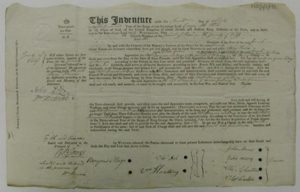
Ann’s Hill is not a street, but a terrace of tall Georgian houses, now numbered 56-59 St Michael’s Street, Shrewsbury. They were originally built by John Simpson, and named after his second daughter, who was christened Marianne in 1793, but was known as Ann. Ann’s Hill was built in conjunction with the nearby Ditherington Flax Mill (opened in 1797), and it is thought to have been the original apprentice house for the factory. Next door (now 55 St Michael’s St) was the house for the clerk (or manager) of the factory. Both these buildings are built of the same bricks as the factory itself, which suggests that John Simpson was also responsible for building the factory.

Typical of those who lived in the Apprentice House was Mary Parsons, who was placed there by the Overseers of the Poor of Prees Parish in 1802 when she was 15. Mary had become the responsibility of the parish, presumably because she was an orphan, and placing her as an apprentice to learn ‘the art and mystery of manufacturing linen yarn’ was a ‘win-win’ situation for both the parish and the factory. The parish was relieved of the burden of providing for her, and the factory got a worker for the cost of providing ‘sufficient meat, drink, apparel, lodging, washing, and other things necessary and fit for an apprentice’ for six years, or until she was married. Whether Mary approved of the arrangement we do not know, since she did not even sign the indenture of apprenticeship.
Ann Simpson’s life could not have been more different from that of Mary Parsons. Brought up in comfort, she moved further up the social scale by marrying John Newton, a retired Indian merchant, in January 1817. Eighteen months earlier her father had died, and the following year her older sister Jane married local physician James Proud Johnson. John Simpson had entrusted his considerable wealth of property and effects to his friend Thomas Telford, who, with the attorney (solicitor) Joseph Loxdale, acted as executor of the will. This arrangement resulted in controversy between Telford and Loxdale and the family, and ended in a suit in the court of chancery. In a bitter exchange of letters in the local press, Telford and Loxdale explained that the problem was not the immediate family, but Dr James Proud Johnson. Indeed, it seems that John Simpson had devised this unusual arrangement so that Johnson could have nothing to do with the estate.

‘Proud’ by name from his mother’s side, Johnson (1785 – 1860) had a combative nature which easily made enemies. On the other hand, he served the Salop Infirmary faithfully for 25 years and had a particular interest in mental health. He also vigorously supported the movement for the proper qualification for those who wished to join the then unregulated medical profession. One battle that he did not win, however, was with some of the other medical staff and the Trustees of the Salop Infirmary. After a protracted and bitter dispute and a general meeting lasting seven hours, Johnson and a young surgeon, Henry Keate, were dismissed. Johnson was aggressive and unwise, but there was more to the case than meets the eye – but that is for the next story!
